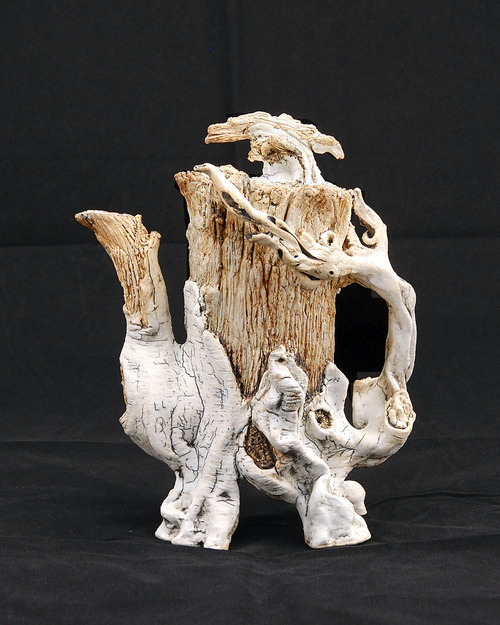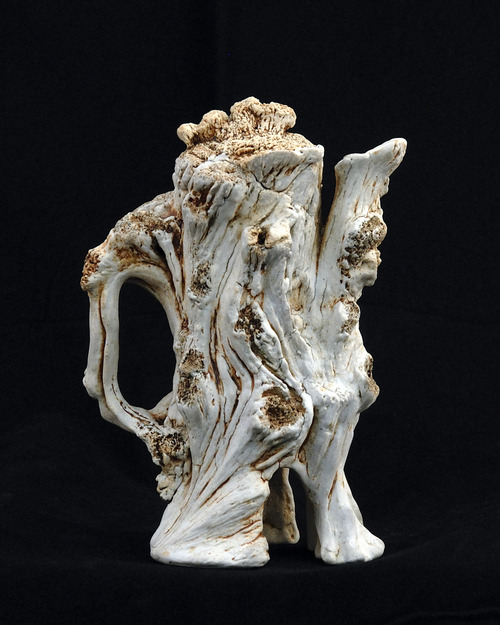
The objects you create realistically mimic the texture and look of wood stumps, roots and branches. What is your connection with this natural element, and why did you choose to investigate it in ceramics?
Human emergence is the overarching theme of my sculptural work; as metaphors for that I use the aging tree as well as the natural land features of the earth. My life connection with trees and land extends from childhood when I remember exploring the woods and mountains of Colorado with my older brother and friends. Today I continue my fascination and exploration with the woods and mountains here in Southern California, where I live a short walk from the local foot trails of the San Gabriel Mountains. Ceramics is the most appropriate medium for me because clay seems to know what I want and interacts with me in a very agreeable way. The characteristics and behavior of clay seems to have a common goal with me as if it wants to behave in a way that yields a pleasing result. Clay naturally takes on the characteristics of wood and earth.
In order to make your work, you use a special process called the Tectonic Method. Tell us more about this technique. How did you develop it and what are its characteristics?
The Tectonic Method is a sculptural technique that utilizes the same tectonic forces that shape and texture the surface of the earth’s crust. These forces include stretching, compressing, and twisting. I begin with an idea of the sculptural object I am going to make and the pieces that will make it up. I then cut a piece of clay from the block that is roughly in the shape of what I want. I then use specialized wire hand tools to pre-texture what will be the visible surface. Next, I “naturalize” the pre-textured clay by tossing, slamming, or dropping the clay against the table top in a way that distorts the tooling of the pre-textured surface. The textured surface is not touched by the hand or tools from then on. The result is a dramatically textured form that is very natural looking. I call this a “tectonic form.” I then use specialized techniques to join together numerous tectonic forms to create a “Tectonic Sculpture” like “The Imaginist” or “The Bearded Ghoul.”
Early in my ceramic studies I began developing The Tectonic Method when I was laying them out on the table top to stretch them out. I could see that stretching clay gave it beautiful patterns of cracks and fissures. I soon discovered that cutting the surface of the clay before stretching it resulted in natural patterns that are easy to reproduce and incorporate into sculptures. The method developed very quickly from there. Since those early experiences stretching clay I have found numerous applications by other ceramists who used stretching as a texturing technique and even a throwing tool designed to apply patterns to vessels thrown on the wheel called the “Steve’s Tool.” A bit of research reveals that stretching clay to achieve decorative textures in clay is a very old tradition. What distinguishes the Tectonic Method from other stretching methods is that it includes specialized techniques for pre-texturing the clay, numerous tossing methods for naturalizing textures, and construction methods for building large clay sculptures that can be prone to slumping to the side during firing. The Tectonic Method is a start-to-finish method of forming and constructing both small and large clay “Tectonic Sculptures.”
Many of your objects are made from paperclay. What are the paperclay’s properties and why did you choose to work with it?
Paperclay is extremely versatile clay that works well with my purposes, especially the Tectonic Method. It remains workable even when it is dry. At bone dry it can be drilled, sawed, and even rewetted. Many ceramists try paperclay and find it difficult to use so they go back to what they were doing. This is unfortunate, and I believe it is because it is the change itself that is the real challenge, not the clay. Paperclay is not difficult to work with at all; it is only different and takes getting used to. Before I began throwing with porcelain I was told it was much more difficult than stoneware to throw. However, it is not more difficult, it is only different in its properties, so the artists must be able to adapt their skills and learn new ones to work with it successfully. I also find paperclay is more economical because it can be very easily reconstituted and go from dry to plastic overnight. If a piece is broken it can be reattached even if it is dry – instead of going in the trash, and the list goes on. However, the primary reason I use it is because of the dramatic textures it produces when it is “pre-textured” and stretched.

David D. Gilbaugh: Sycamore Teapot #3, 2011, sculpted teapot, 11”(H) x 8”(D), hand-built slab, B-mix stoneware paper clay with grog, cone 10 reduction, black stain brushed in crevices, water washed iron and rutile stain over porcelain decorating slip.
Some would argue that real art is free from any utilitarian purpose, yet your “Treepots” series state the contrary. Do you think that art and practical use can truly merge into one object alone?
My “Treepots” are sculptures of teapots, just as a sculpted head is a sculpture of a head. That said, most of my teapots will hold and pour tea, some do it well, some don’t work at all, but they are all made to be works of art. If one chooses to make tea with it that does not disqualify it as art. Looking at one of my teapots you can not usually tell if it works; regardless – my intention is to make a sculpture of a wooden teapot. So my answer to your question is yes.
When creating a special technique, many artists would rather keep it for themselves. Yet, you have workshops where you teach others your technique. What have you learned from these experiences?
My experience is that some people feel the need to keep their techniques a secret because they don’t want others to “steal” them and become competition. This has not been my experience. I share my techniques openly because it is fun to teach and see others share in my experience.
What motivates you as an artist? Do you think that ceramics is a suitable medium for young artists?
What motivates me as an artist is the making of my art itself. Sculpting is fun and a wonderful means to express my thoughts and feelings that I can not put into words.
Ceramics is a wonderful medium for young artists. Clay is inexpensive and very forgiving so it is especially well suited for young artists who are learning from trial and error.
Interview by Ileana Surducan, published in Ceramics Now Magazine, Issue 2.


















